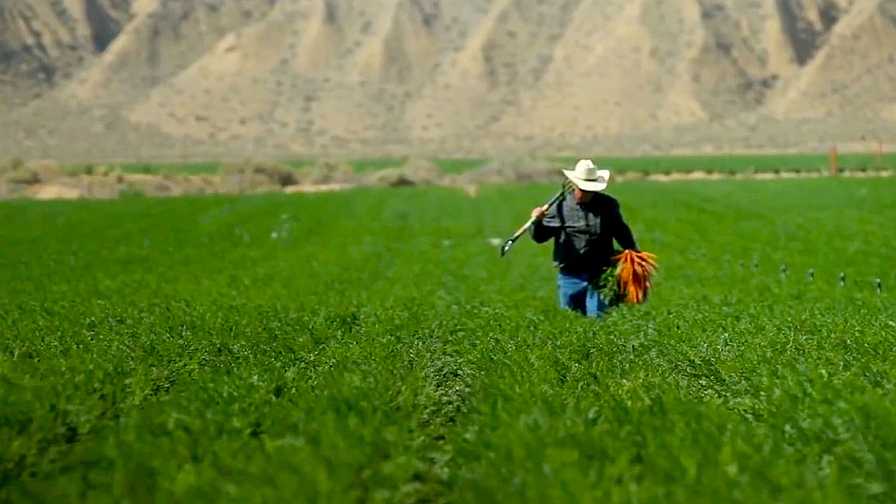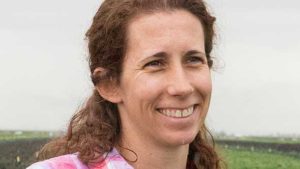How to Trial Biocontrols on Your Farm

Southern California-based Grimmway Farms is committed to being a leading supplier of organic produce. With that, biocontrols has become a large part of what the operation’s production plan. Finding the right products though takes time. Photo courtesy of Grimmway Farms
Grimmway Farms’ Kimberly Gallagher Horton faces a few challenges when it comes to field testing new biocontrol products. For one, a lot of third-party testing is done on non-vegetable crops. Also, the field size of the research doesn’t always translate to large operations like Grimmway.
Drawing on her laboratory training, Horton has developed an extensive field-testing program that helps the Grimmway team select which products will be used throughout the operation. We talked to Horton to learn more details.

Kimberly Gallagher Horton
Q: How do you pick the biocontrols to trial?
Horton: You want to make sure the company you are working with has done research on that crop to support its claims. If it has not, find out if it has plans to do so. Does it have third-party researchers and consultants set up? I have often told suppliers that we’re not a research company, we’re a production farm. We can do some trial work, but I first need the company to prove the efficacy on a crop we grow before I dive into a product. People always want to come to us with berries, and permanent crops. [They] say, ‘Oh, well, we’ve used it on these, so it should work well on your vegetables.’ They’re just so different.
Q: What is the next step once you’ve decided to trial a product?
Horton: Usually we try to give [biocontrol companies] an acreage suggestion, decide what area we want to trial it on, get training on the product in place, and make sure the product is U.S.-approved for use and add it to our approved-materials list. You have to go through all the steps of the paperwork. Part of picking the trial area is to always have a control area. That’s really important.
Q: Do you need to have a true comparative area?
Horton: Yes. Make sure it’s not on the edge of the field or in the weakest part of the field. People want to view it on the edge, but the edges are not representative of the whole field. The control and test fields need to be as parallel as possible. Look at the soil conditions along with size. A big field will have a really sandy area on one spot where you know your numbers are going to be less. You don’t want to skew your data. If you know that a sandy area is going to be on your control side or on your treatment side, you have to account for that.
Q: How do you do that? Because that sounds complicated.
Horton: Oh, it is. The next step is to replicate. I really like to have at least three fields, though if I can, I’ll get closer to five or six fields for the trial. Our trial fields average about 60 acres, and you want three to six fields, and to replicate the trial across all of those. That reduces the field variability of the soil. Because something is almost always going to go wrong. One field is not going to get treated, or someone is going to put on the wrong amount of product. That’s why I like five or six fields. If something goes wrong in a field, and you only have two good trials, that’s not very good data.
Q: It sounds like a real commitment to whatever you’re trialing.
Horton: I want to get good information. I don’t want to go through all the trouble of setting it up and not having replicates to give me good data across the board.
Q: Are any of the crops in the trial going to be sold, or is that purely for testing?
Horton: It’s all for sale. We don’t do any crop-destruct trials. Once again, we’re a production farm. Everything and all the products we use are on our approved list. There’s no issue with selling vegetables that have been treated with it. It’s about whether or not we’re going to get a return on investment for that treatment. And that’s what I’m trying to determine.
Q: How do you determine success?
Horton: We’re going to see the differences at harvest. All of our fields have GPS coordinates, and when the harvester goes through, we can know, exactly, the yield in that area. When I set up the trial, I have one lot number for the control, one lot number for the treatment, and then I can get that information once I have harvested so I can confirm the numbers.
Q: What are some of the criteria you’re looking for in the trials? Is yield the number there, or is there a range of things you’re looking at?
Horton: Yield is definitely No. 1. No question. Because you’re putting additional money into the crop. So does that additional spending give you a higher yield to justify the use of it? And quality is another area. Even if you don’t get higher yields, is it a stronger lettuce leaf, or does the product have a better quality without whatever product you’re adding? We look for disease suppression, too. Does it help the plant take up nutrients better? All of these other things are related to getting a better yield. For instance, less disease means better quality, which leads to better yield.
Q: How do you track the trials?
Horton: It depends on the crop that I’ve done the trial on. There are certain crops that we grow, where it’s very easy. If they’re going to mechanically harvest the entire field, I can set different lot codes with GPS coordinates, and I can get the data from the facility where it’s processed, which is our facility. That’s the best way for me to run field trials. Where it gets more difficult is when they don’t harvest everything in the field at once. That can be because of an issue in that area of the field, or it could be the sales are lower or higher than what we expect. So it depends on which vegetable we’re trying out the trial on. It changes the level of difficulty.
Q: Any tips for those who do not mechanically harvest?
Horton: What I do with, say, spinach, is to get in there before the harvester goes in. I’ll do my own harvesting from areas, and get a field sample. It’s not the entire field, so it’s not entirely representative, but I collect maybe six data points and compare one side of the field to the other. That’s another way to do it if you can’t get the data from the whole field. I often do multiple field pulls in multiple areas to reduce the variability because you might pull from an area that was a weaker part of the field and get a smaller number. I’ll work my way from one end of the field, doing pulls all the way across. Then I’ll do the same pattern on the other side of the field. I’m comparing apples to apples as much as I can, and then I do the data from there.
Q: Are you looking at weight, color, and count?
Horton: Yes, and length, like on carrots. Weight is nice since it’s across the board. It’s not subjective. You weigh it, and this area weighs more than this area.
Q: That’s quite a bit of work. How often are you doing that in a trial? Is that every time or with certain crops?
Horton: It depends on the trial. I mean, we’ll even do leaf and petiole sampling. On those, you have to walk the field once a week to get the samples, take them to the lab and get the data. It depends on what kind of trials. On other trials, it’s going to be something we are going to add to the soil, so it’s done at planting and then I collect the data at the end, and I’m done. I never have to pull the samples. What we’re looking at determines how intense the data collection will be.










